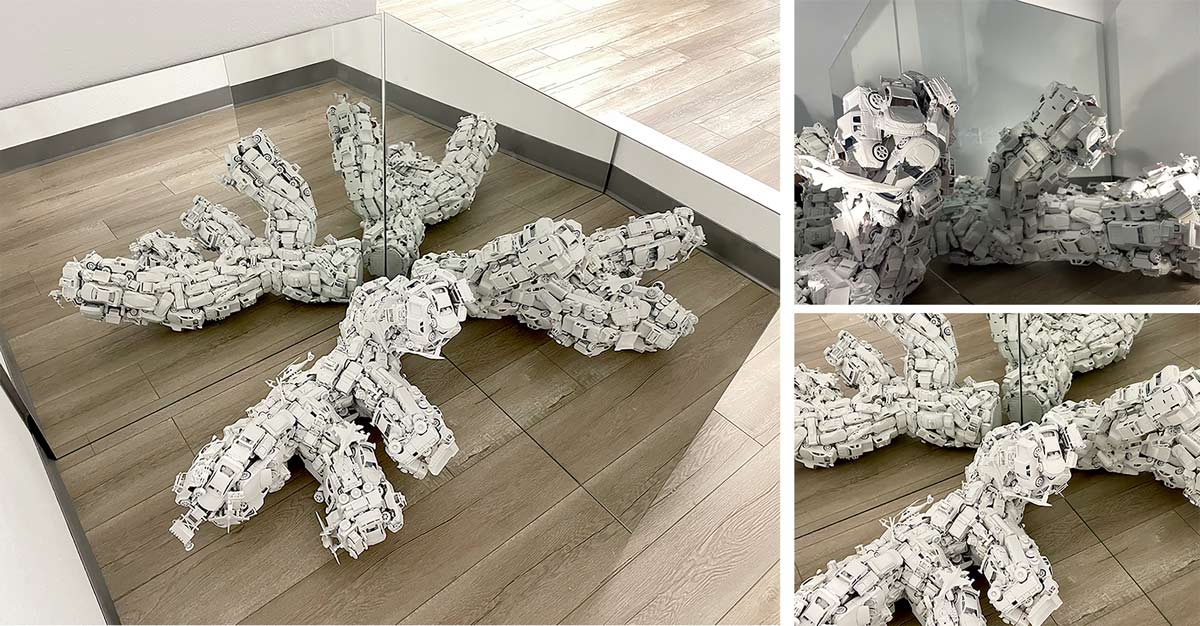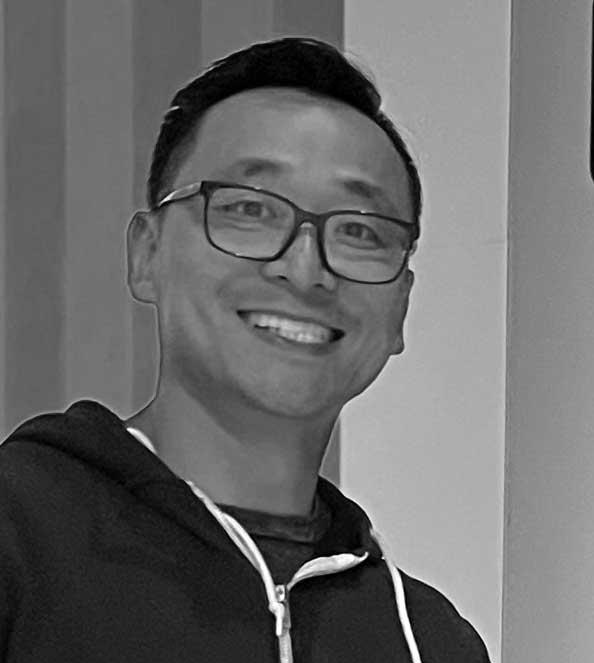

AP 3-D
Crescenta Valley High School|
La Crescenta, California
Sooah Lee


Dimensions: 27” x 42” x 42”|Material(s): Mirrors, toy vehicles, spray paint|Process(es): Shaped a coral, glued vehicles, and spray painted white to show how vehicle emissions kill coral|Curatorial Note: This is one of many interesting works that we saw in this portfolio. The use of the corner mirror is an impressive use of expanding the space of the form.
Student statement
Student statement
How do our daily decisions impact our environment? This was the question that I continuously asked myself throughout the whole year of AP 3D Art. As someone who grew up loving nature, from watching my favorite cartoon animal show, Wild Kratts, to numerous camping trips every school break, it helped me to notice the changes our planet was going through that others could not. With my growing interest in environmental science and art, I combined the two subjects I love most for my AP 3-D Art and Design inquiry. Making art is essential for me to explain urgent ideas that people may not be familiar with. As Earth becomes more degraded by human and corporate interference, I wanted to bring attention to these issues to help us gain a clearer, more embodied understanding of our actions. My art can help the environment gain a voice.
One of the art installation pieces I made for the exam was "White Death," a piece about how carbon dioxide from vehicle emissions contributes to ocean acidification and its negative impact on marine life. I considered the material I used in every piece, mainly reusing or repurposing items that would have been thrown out. Specifically, in this piece, I repurposed old toy cars that my brothers no longer used, which would have piled onto landfills if I had not. I also thought about how my chosen materials could enhance how the viewers see and think about the piece. It was a challenging but fun process of finding the best materials to help convey the meaning and idea that I wanted to share, as the slightest detail could help bring the whole work to another level. In this work, I felt that something was missing. After multiple trials and errors, I added mirrors to multiply the dead coral I made, symbolizing the continuous cycle of marine animals affected by rising CO2 levels from vehicle emissions. The mirrors worked as the unveiling of the culprit for the damaged environment: the viewers. As I had hoped, this last element helped make the piece more interesting and complex.
The pieces I made for the AP Art and Design portfolio show our impact on the environment in different ways. While "White Death" and most other pieces focus on the negative impact, a few are positive and display hope. Although they all show impact through various topics, they all show a clear warning and message of what we should do to help the environment.
My biggest takeaway from making my artwork would be never to doubt myself and let it happen. Revision allowed me to complete artwork to my expectations and beyond.
Sustained Investigation, Materials: sketchbook|Process(es): Mirrors create four corals to show the continuous cycle of marine animals dying from rising CO2.

TEacher statement
TEacher statement

Ricky Ngai
I had the privilege to have Sooah Lee as an art student for two years. Her mature point of view and sophisticated 3-D Art and Design techniques have given her work an adult quality, with youthful energy and freshness. Combining her passion for Environmental Science and Art, her works are not restricted by any art medium. There is evidence of risk-taking and experimenting with various found materials in her art installations. As a result, her art portfolio demonstrates a high caliber of success and clear intent with the sustained investigation.
Some strategies to help my students start the inquiry process are mind-mapping a topic or starting with an open-ended question to guide their art-making. I always encourage students to ask a question about a topic/concept/issue relevant to personal importance.
Sometimes, students can start with a metaphor, an experience, or a quote and grow into more specific questions in the mind-mapping exercise.
I always remind students that they may start the school year with one inquiry question, but as they create more work, it is a living, breathing investigation that can grow and branch out. Their work may evolve into other ideas but is still connected to the central question. The entire process of inquiry is a wheel cycle of creation with deeper meaningful ideas rather than concentrating on a final product.
As an AP Art and Design teacher, one of the challenges for me is to provide skill development and inquiry support in a very short time. Fortunately, our school’s art program offers multiple levels of art courses, so students can develop fundamental art skills for at least two years before taking AP art courses. Because I teach all levels of art courses, I structure my curriculum with a vertical alignment in mind and create art assignments to allow opportunities for students to explore different art mediums and go deeper into art content. The year before, students take AP Art and Design courses, and during summertime, my students are exposed to the structure of the AP exam and look at AP artwork examples for inspiration.
I advise AP Art and Design teachers to help students be organized with time management. Set up due dates for each sustained investigation work and allow them to resubmit for better grades before the end of each semester. Otherwise, students will wait until the last minute to create artwork with extremely poor results. Since the exam asks for submitting 15 images rather than 15 'finished' artworks, I encourage students to make less artwork with stronger results, emphasizing the creating process rather than the final product.
Aside from turning in 'finished' art products, I ask students to create process images as class assignments. Another piece of advice is to spend some quality time in class to review the scoring rubrics and exam expectations. The College Board AP Classroom videos (under the review section) use clear student examples and are an excellent resource for identifying the rubrics. Lastly, students sometimes get into a rut because it is a long journey of focusing on the same investigation. To help them get 'unstuck,' I encourage them to experiment with different media, make mistakes, get out in nature, take lots of pictures, take a break, revise but don’t restart, take risks and make a big change.

As my love for nature grew, so did the negative impacts on it by humans. I decided to reveal hidden truths about our decisions and give the environment a voice.
Principal statement
Principal statement

Christine Benitiz
It's with great pleasure that I commend Sooah Lee and the Art program at Crescenta Valley High School in the Glendale Unified School District. Our school's mission centers on cultivating critical thinking, mastering standards, and providing students with the resources to acquire the essential skills, knowledge, and values for responsible and productive societal engagement. Sooah Lee epitomizes success that is aligned with our mission statement. Her artwork boasts captivating visual aesthetics and demonstrates her adeptness in critical thinking by seamlessly blending Arts and Science in her creations.
In 2019, our school received recognition as a California Distinguished School, distinguishing itself as the sole institution in the state acknowledged for outstanding programs in both the Arts and Physical Fitness and Nutrition. The Visual Arts program stands out, consistently securing the highest number of art awards and accolades. Over recent years, there has been a significant surge in student interest in art courses, exemplified by a 50% increase in enrollment in the AP Art and Design program this year. I take pride in acknowledging Mr. Ricky Ngai, an exceptional art teacher whose dedication significantly contributes to the success of the art program. He genuinely cares about students' artistic education, inspiring them to reach for greatness. While maintaining high standards, he adeptly identifies and nurtures students' strengths, guiding them to discover their distinct voices and styles in their artistic pursuits. I speak of Mr. Ngai with confidence, having witnessed his impact on my eldest daughter, who is now on the path to becoming an art historian or educator.
I extend my heartfelt congratulations to Sooah Lee for her selection in the 2023 AP Art and Design Exhibition. Her accomplishment is a source of great pride for us, and we wholeheartedly wish her the very best for her future endeavors.

Sooah Lee





